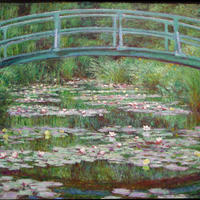More about The Arnolfini Portrait
- All
- Info
- Shop

Sr. Contributor
There's only two things you can know for certain about the Arnolfinis: No one knows anything, and everyone's a pervert.
Maybe the pair is married. Maybe they're about to be married. Maybe the lady's dead. Maybe they just want good luck for having kids. Maybe they're about to have a kid. Just stop with the questions and understand that this is one of those paintings where you can write your own story about it and instantaneously become a scholar.
For certain, the Vladimir Putin looking fella is named Giovanni Arnolfini. But it's impossible to tell which Giovanni Arnolfini we're talking about. Whichever Arnolfini this is, he was the go-to money man for the Medicis and local royalty alike. The Arnolfini family were Italian transplants in the city of Bruges, acting as the local wolf of Wall Street types. The woman could be Giovanna Cenami or Costanza Trenta. Both belonged to high-powered Italian finance families looking to get an in with the Arnolfinis. The Giovanni that married Giovanna got hitched 14 years after van Eyck finished this portrait, and the Giovanni that married Costanza was a widower by the same time. Confused? Just stop worrying about it and enjoy the painting.
There are a couple things that we can be certain about. No matter what anyone tells you, the lady is not preggers. Every fashionistaof the time bunched up fabric to make a front badonkadonk in public. Also, everything in this painting is either about piety before God or boning. Sometimes both. The dog, slippers, red sheets, lit candle, and oranges are either there to remind everyone how to be a faithful husband and wife in the eyes of God, or to let everyone know that the Arnolfinis were trying for kids like a couple barnyard animals. Even things like the rosary on the wall next to the mirror spoke to both piety and boning. Because nothing gets a normal person hotter than praying about your iniquities to an eternal, ambivalent Father-God #hotdamn.
Speaking of the mirror, it's quite the talk of art historians. It paved the way forward for a theory of linear perspective before that was a thing with a name. For van Eyck, this was all guesswork and good fun. For everyone else, it was a huge leap forward in how a painter makes the viewer interact with a painting. So whenever you see famous works that mess with perspective and your sense of reality, they only exist because van Eyck was a smart ass messing around with big ideas. The mirror is even the site of some good-old fashioned graffiti and photobombing. Jan van Eyck signed the portrait right between his patron's heads. Not even in a classy way. The signature translates from Latin as, "Jan van Eyck was here 1434." On top of that, he photobombs the poor Arnolfinis by putting himself in the mirror's reflection, waving like a goofball.

Sr. Editor
Jan van Eyck changes the face of art forever with the Arnolfini Portrait.
You may feel clever writing your name and that 'you were here' whenever you have a chance, but Jan van Eyck did it in 1434. He wrote 'Johannes de eyck fuit hic 1434' smack in the middle of a wealthy client's portrait. I don't think the Kardashian-Wests be ok with that.
The Arnolfinis were fabulously wealthy, at least for merchants in 1434. They show off for us with their elaborate chandelier, the fur-lined clothes and, believe it or not, the oranges. They might've been trying a little too hard ... Mr. Arnolfini is wearing a straw hat meant for the summer and the ripe cherries and oranges indicate it's summertime and yet, the Arnolfinis are layered up in every single fur they own. Let's dress appropriately for the season guys. Speaking of weird fashion choices; Mrs. Arnolfini is not pregnant in this painting. It was the fashion of the time to look like you had a huge stomach, which was achieved by putting as much fabric as possible on your front.
The painting was bought by the National Gallery in London in 1842 for £600.
There's no explanation as to why the husband and wife both look like Vladamir Putin. Art history pro-tip: anytime someone in the painting looks like Putin, it's by Van Eyck.
This painting hangs in the Shadow Gallery in the movie V for Vendetta.
Featured Content
Here is what Wikipedia says about Arnolfini Portrait
The Arnolfini Portrait (or The Arnolfini Wedding, The Arnolfini Marriage, the Portrait of Giovanni Arnolfini and his Wife, or other titles) is an oil painting on oak panel by the Early Netherlandish painter Jan van Eyck, dated 1434 and now in the National Gallery, London. It is a full-length double portrait, believed to depict the Italian merchant Giovanni di Nicolao Arnolfini and his wife, presumably in their residence at the Flemish city of Bruges.
It is considered one of the most original and complex paintings in Western art, because of its beauty, complex iconography, geometric orthogonal perspective, and expansion of the picture space with the use of a mirror. According to Ernst Gombrich:
[I]n its own way it was as new and revolutionary as Donatello's or Masaccio's work in Italy. A simple corner of the real world had suddenly been fixed on to a panel as if by magic... For the first time in history the artist became the perfect eye-witness in the truest sense of the term.
The portrait has been considered by Erwin Panofsky and some other art historians as a unique form of marriage contract, recorded as a painting. Signed and dated by van Eyck in 1434, it is, with the Ghent Altarpiece by the same artist and his brother Hubert, the oldest very famous panel painting to have been executed in oils rather than in tempera. The painting was bought by the National Gallery in London in 1842.
Van Eyck used the technique of applying several layers of thin translucent glazes to create a painting with an intensity of both tone and colour. The glowing colours also help to highlight the realism, and to show the material wealth and opulence of Arnolfini's world. Van Eyck took advantage of the longer drying time of oil paint, compared to tempera, to blend colours by painting wet-in-wet to achieve subtle variations in light and shade to heighten the illusion of three-dimensional forms. The wet-in-wet (wet-on-wet) technique, also known as alla prima, was highly utilized by Renaissance painters including Jan van Eyck. The medium of oil paint also permitted van Eyck to capture surface appearance and distinguish textures precisely. He also rendered the effects of both direct and diffuse light by showing the light from the window on the left reflected by various surfaces. It has been suggested that he used a magnifying glass in order to paint the minute details such as the individual highlights on each of the amber beads hanging beside the mirror.
The illusionism of the painting was remarkable for its time, in part for the rendering of detail, but particularly for the use of light to evoke space in an interior, for "its utterly convincing depiction of a room, as well of the people who inhabit it". Whatever meaning is given to the scene and its details, and there has been much debate on this, according to Craig Harbison the painting "is the only fifteenth-century Northern panel to survive in which the artist's contemporaries are shown engaged in some sort of action in a contemporary interior. It is indeed tempting to call this the first genre painting – a painting of everyday life – of modern times".
Check out the full Wikipedia article about Arnolfini Portrait























